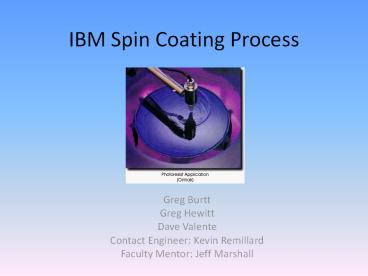IBM Spin Coating Process - PowerPoint PPT Presentation
1 / 8
Title:
IBM Spin Coating Process
Description:
Typical Photolithography Process. During the spin coating process, defects sometimes appear on the wafer. ... Damage to the bowl from handling and cleaning have ... – PowerPoint PPT presentation
Number of Views:1202
Avg rating:3.0/5.0
Title: IBM Spin Coating Process
1
IBM Spin Coating Process
- Greg Burtt
- Greg Hewitt
- Dave Valente
- Contact Engineer Kevin Remillard
- Faculty Mentor Jeff Marshall
2
Typical Photolithography Process
3
IBMs Problem
- During the spin coating process, defects
sometimes appear on the wafer. - Damage to the bowl from handling and cleaning
have also been spotted as a cause of the defects. - A cleaning process must be run a few times a day
to remove built up resist from the bowl set (a
3-part set of plastic pieces that houses the
silicon wafer being coated and collects the
excess applied chemicals) in order to reduce the
probability of defects. - This cleaning process involves the use of a
cleaning disk and a solvent to attempt to remove
as much resist as possible from the bowl, but it
is incapable of removing all of the build-up. - Consequently, the bowl set must be removed every
two weeks and trucked to a company that cleans
them. This is a very costly process for IBM for a
few reasons. - There is a lot of down-time involved in removing
and replacing the bowls, this is time translates
directly to lost money because of decreased
productivity. - They must also pay to have the bowls trucked to a
facility and to have them cleaned there. - Some bowl sets come back with damage and need to
be replaced.
4
Defect Description
- Wafer defects are thought to be caused by the
loss of proper air flow through the bowl setup. - Very small particles (ball bearings) of resist
become suspended in the air during the normal
application process, the flow ideally carries all
these particles away from the wafer surface into
a drain. - In some cases, the flow becomes disrupted
allowing these particles to return from the air
to the wafer surface. Alternatively, the flow
picks up new ball bearings from the sides of the
bowl and deposits them on the wafer surface.
Either instance results in a defect on the wafer. - IBM believes, and we will assume their conclusion
is correct, that in an otherwise undamaged bowl,
these defects are primarily caused by a build-up
of dried resist on the bowl surfaces.
5
Goal
- Our goal is to reduce the cost to IBM of
maintenance and upkeep of the bowl sets by
altering the coating or cleaning process. Thereby
allowing bowls to be changed less often, reducing
cleaning costs and the risk of damage during
handling. Two fundamentally different approaches
can be taken.
- Airflow To decrease the sensitivity of the
spin-coating process to imperfections in the bowl
such as dried resist. - Material and Cleaning To reduce the ability of
the resist to collect on the sides of the bowl in
volumes that have a detrimental effect on the
spin-coating process.
6
Possible Solution Avenues
7
Two Testing Options
- Airflow
- Buildup of Resist
- If the airflow path on the flow chart is taken, a
full experimental setup must be created. The flow
velocity, angular velocity of the wafer, and
internal geometry of the photoresist application
machine must be accurately replicated. This would
allow us to make alterations to the velocity,
knife edge, roughness, and bowl geometry and test
their effects. This would be done with a mix of
computer simulation and visual observation using
suspended particles such as what would be found
in smoke or the vapors of dry ice.
- If the resist buildup path is chosen, the
experimental setup can be greatly simplified. The
bowl set and chamber would be used mainly to
characterize the resist buildup and test cleaning
disk designs and process changes. Material and
coating ideas would be tested on samples obtained
from manufacturers. Parameters such as contact
angles could be measured and compared. Resist
could also be applied and dried onto the samples,
then the ease of removal could be assessed
experimentally.
8
Constraints
- Process chemicals cannot be changed
- Wafer spin speed is variable, so a solution must
accommodate any angular velocity up to a maximum
of several thousand RPMs - IBM prefers that the bowl geometry remain
unchanged - Exhaustive testing would have to result
- Cost to IBM can not increase
- This includes the cost associated with bowl
manufacture and cleaning as well as equipment
down-time for cleaning and bowl changes































